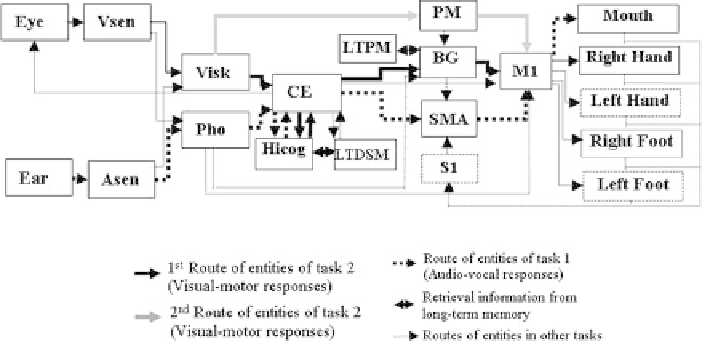Information Technology Reference
In-Depth Information
Fig. 9.5: The general structure of the queuing network model (QN-MHP) with
servers and routes involved in the PRP task highlighted (server names, brain struc-
tures, major functions, and processing time are shown in Table 9.1).
phenomena. However, entities traverse different routes while performing PRP tasks
than they traversed when performing typing tasks.
Because the PRP effect prior to or at the beginning of learning (the basic PRP)
is a special case of the PRP effect during the learning process, the two phenomena
of PRP (basic and learned) are modeled with the same mechanisms in our queuing
network model. The experimental tasks and data of Van Selst et al. [49] were used
to test the model.
Brain areas (servers) and their routes related to the two PRP tasks in Van Selste's
study were identified within the general queuing network structure based on recent
neuroscience findings [32, 15, 2], see Fig. 9.5). When exploring Fig. 9.5 entities
of task 1 (audio-vocal responses) cannot bypass the Hicog server because the 26
phonological judgment function is mainly mediated by the Hicog server, and thus
there is only one possible route for the entities of task 1 (see the dotted thick line in
Fig. 9.5) to traverse. However, the function of movement selection in task 2 (visual-
motor responses) is located not only in the Hicog server but also in the PM server.
Therefore, there are two possible routes for the entities of task 2 starting at Visk
server (see the gray and black solid lines in Fig. 9.5).
However, how might the entities of task 2 choose one of the two alternative
routes in the network? What is the behavioral impact of this choice on PRP and the
practice effect on PRP? These questions can be answered by integrating queuing
networks with reinforcement learning algorithms. Before exploring the mechanism
with which entities of task 2 select from one of the two routes, it is necessary to un-
derstand the learning process of individual brain areas. It was discovered that each
individual brain area reorganizes itself during the learning process and increases its
processing speed [44]. For example, for the simplest network with two routes (see
Fig. 9.6), if servers 2 and 3 change their processing speeds, different routes chosen
by an entity (1
→
3
→
4or1
→
2
→
4) will lead to different performance. Without con-

